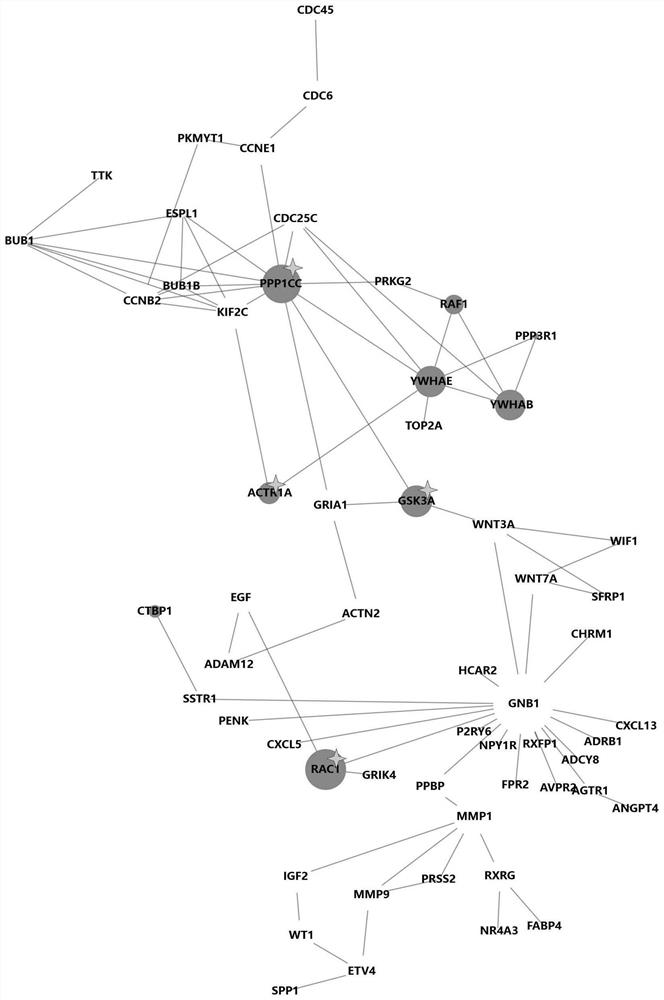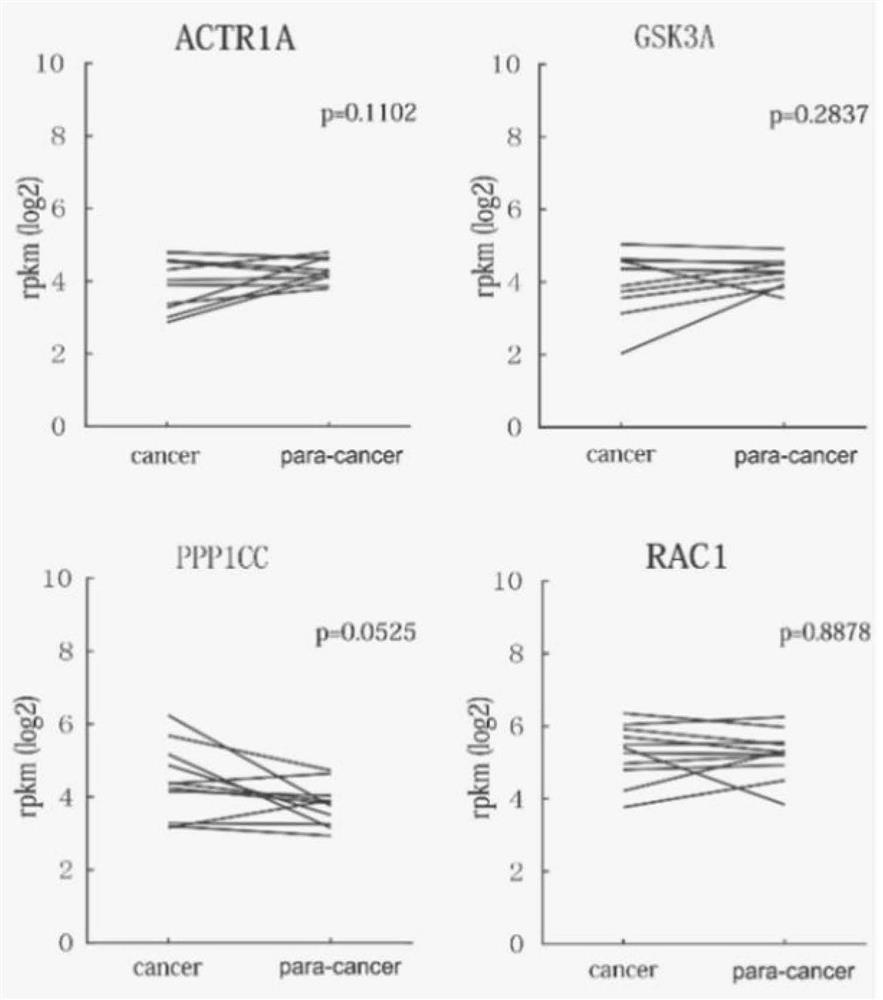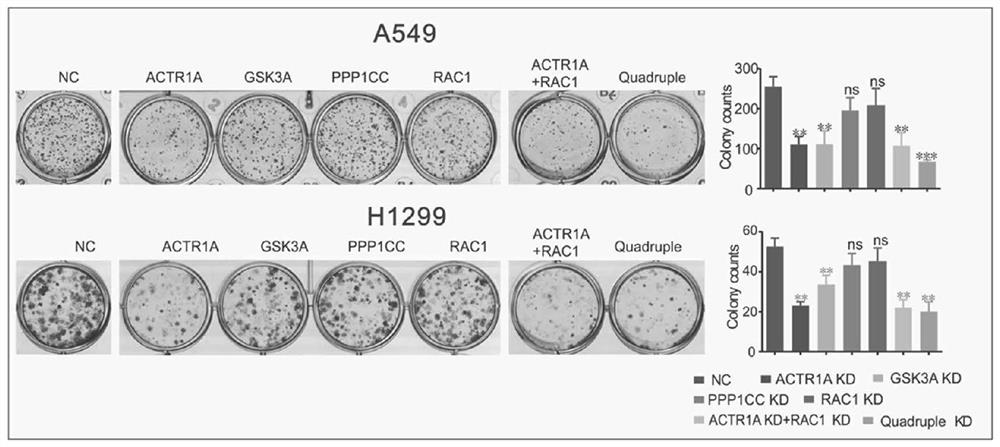Non-differential gene associated with malignant phenotype of tumor cell as well as screening method and application of non-differential gene
A technology of differential genes and tumor cells, applied in the field of bioinformatics, can solve the problems of unsatisfactory treatment effect of middle and advanced lung adenocarcinoma, high cancer heterogeneity, and numerous pathways
- Summary
- Abstract
- Description
- Claims
- Application Information
AI Technical Summary
Problems solved by technology
Method used
Image
Examples
Embodiment 1
[0111] The mRNA sequence data of 75 pairs of lung adenocarcinoma / paracancer specimens were downloaded from the NCBI-SRA database (SRA: ERP0001058). Taking the 150 cases (75 pairs) of lung adenocarcinoma and adjacent clinical tissue samples as an example, the non-differential genes in the samples were screened, and the non-differential genes ACTR1A, GSK3B, PPP1CC and RAC1 were obtained. The specific process is as follows:
[0112] ①The mRNA sequences of 75 pairs of lung adenocarcinoma / paracancer specimens were converted into FASTQ format by using the parameter split files of the software SRAToolkit v2.8.2, and the sequence alignment algorithm FANSe was used to map the first end to the transcriptome reference sequence hg19, with an error of 6 %. Genes (with >10 mapped reads) were quantified by the rpkM method.
[0113] The number of mRNA sequences is denoted by n, while the number of genes with a value greater than or equal to 0.1 rpkM in the nth mRNA sequence is denoted by m. ...
Embodiment 2
[0129] The non-differential high expression of embodiment 2 non-differential gene
[0130] In order to confirm that in random samples, the four target genes obtained in Example 1 have the same trend, the cancer and paracancerous tissues of 12 Chinese lung adenocarcinoma patients were collected for sequencing, and the four non-differential genes screened in Example 1 were explored. Whether genes are not differentially expressed in a random sample.
[0131] According to the kit manufacturer's protocol, the standard MGIEasyTM mRNA library preparation kit V2 was used to prepare the mRNA seq library from the cancer and paracancerous tissues collected from 12 Chinese patients with lung adenocarcinoma. Sequencing was performed on a BGISEQ-500 sequencer in single-end 50nt mode. After the obtained sequencing data is qualitatively and quantitatively analyzed by the FANSE series algorithm, check whether the expression level is different.
[0132] In Example 1, the expression levels of ...
Embodiment 3
[0133] Example 3 The role of non-differential genes in proliferation, migration and invasion of lung adenocarcinoma
[0134] The human lung adenocarcinoma cell lines A549, NCI-H1299 and normal lung epithelial cells HBE used in this example were all purchased from ATCC, and all cell lines had STR reports and mycoplasma negative certificates, and the cells did not appear third-class at each locus Epigenetic phenomenon, no human cell cross-contamination was found in the cells.
[0135]Cell culture: A549, NCI-H1299 and normal lung epithelial cells HBE were inoculated in the medium respectively, in 5% CO in DMEM (Gibco) 2 Cultivate in an incubator, and the medium is a medium supplemented with 10% fetal bovine serum (FBS), 110 mg / L sodium pyruvate and 1% penicillin / streptomycin at 37°C. Before transfection, 5×10 5 Cells were seeded in 6-well plates for 24 hours. Then use Lipofectamine TM 3000 Transfection Reagent (Invitrogen) Cells were transfected with 100 pmol of siRNA and in...
PUM
 Login to View More
Login to View More Abstract
Description
Claims
Application Information
 Login to View More
Login to View More - R&D
- Intellectual Property
- Life Sciences
- Materials
- Tech Scout
- Unparalleled Data Quality
- Higher Quality Content
- 60% Fewer Hallucinations
Browse by: Latest US Patents, China's latest patents, Technical Efficacy Thesaurus, Application Domain, Technology Topic, Popular Technical Reports.
© 2025 PatSnap. All rights reserved.Legal|Privacy policy|Modern Slavery Act Transparency Statement|Sitemap|About US| Contact US: help@patsnap.com



